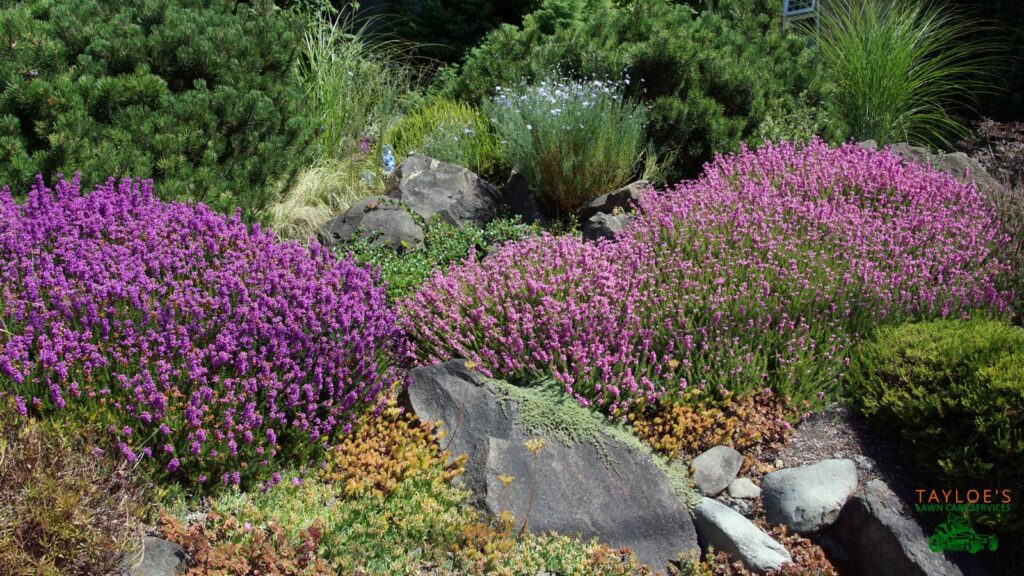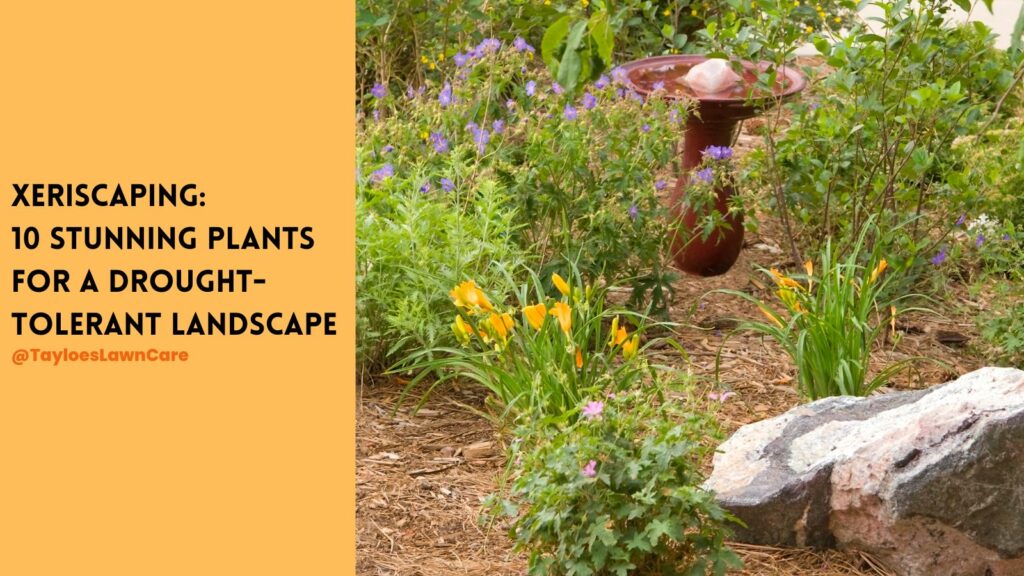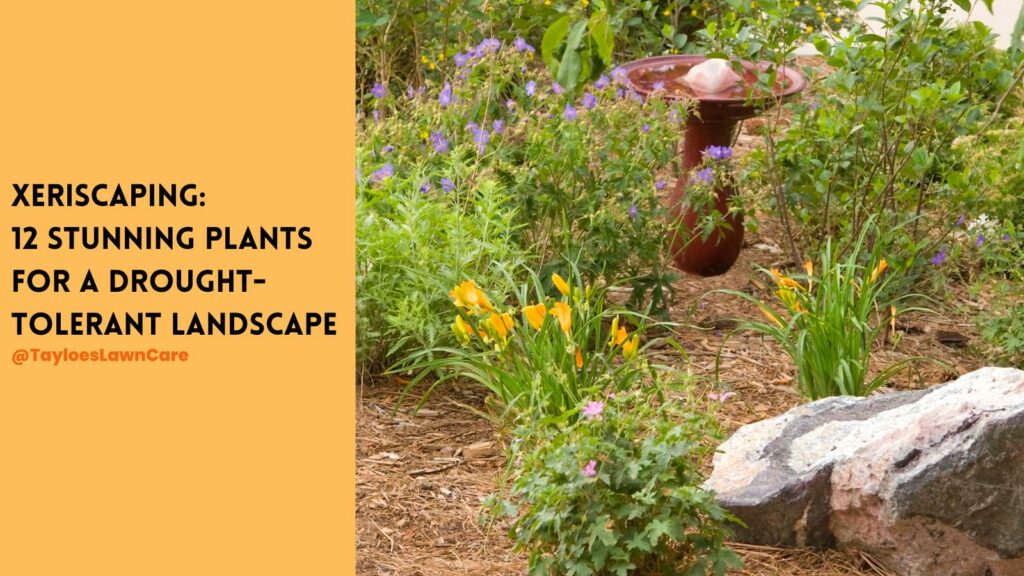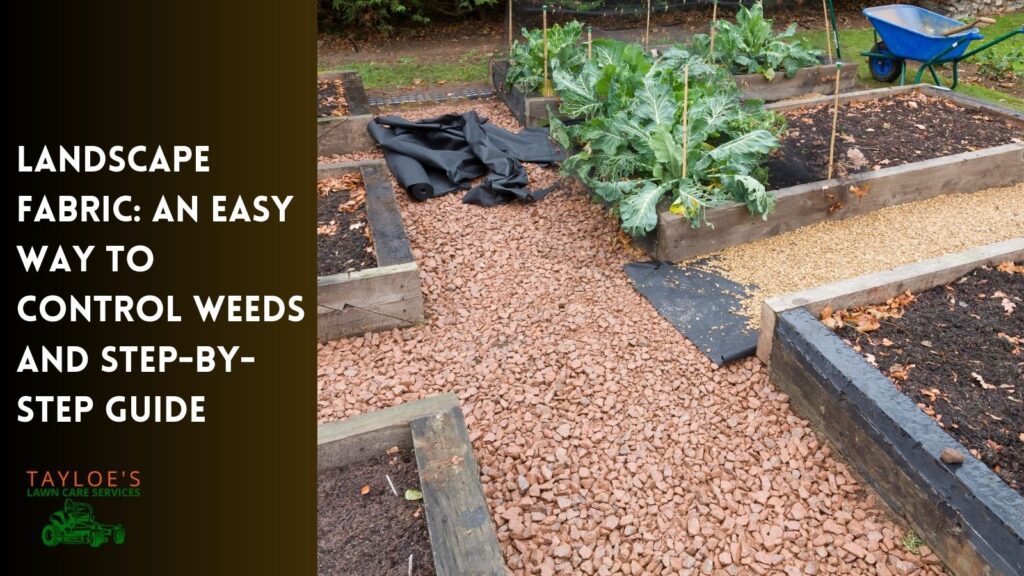Last Updated on: 21st May 2024, 02:35 pm

Drought-resistant perennials are key to gardening success.
Navigating the gardening world in Northeast North Carolina can be a delightful challenge, especially when your goal is cultivating a drought-tolerant perennial garden.
This guide is designed to guide you through the whole process, from planning your garden to the essentials of maintenance.
Along the way, we’ll discuss selecting the right plants and share tips for ensuring your garden not only survives but thrives.
Let’s dive right in!
Step one…
Before breaking ground on your new drought-tolerant garden, thoughtfully designing your space is crucial.
This involves considering several key factors that will influence your garden’s overall success and aesthetic.
Drought-Tolerant Perennial Garden Design
Assess Sun Exposure
The amount of sunlight your garden receives daily will significantly affect which plants you choose and where you will place them.
- Observe Sun Patterns: Spend a few days noting how the sun moves across your space.
Identify areas that receive full sun (6+ hours of direct sunlight), partial sun or shade (4-6 hours of direct sunlight), and full shade (less than 4 hours of direct sunlight).
- Map Out the Areas: Draw a simple garden map and mark these sun exposure zones. This will serve as a guide when selecting plants suited for each area.
Consider Existing Landscape Features
Incorporating existing landscape features can enhance the natural charm of your garden and reduce the need for new materials and plants.
- Identify Key Features: Note any existing trees, shrubs, pathways, or decorative elements like rocks or water features. Decide which features should remain as focal points.
- Plan Around These Features: Design your garden layout to complement these elements. For example, use a beautiful old tree as a natural shade provider for shade-loving plants.
Reflect on Personal Preferences
Your garden should be a reflection of your personal style and functional needs.
- Choose a Theme: Whether it’s a color scheme, a particular style like cottage or modern minimalist, or inspired by a specific habitat like a prairie or woodland.
- Think About Usage: Consider how you intend to use the garden. Do you want a space for relaxation, entertaining, or simply viewing from your home?
This will influence the design and choice of plants.
Draft the Garden Layout
Considering these factors, create a rough sketch of your garden. Use it to visualize plant placement, pathways, features, and structural elements.
This plan doesn’t have to be to scale but should serve as a blueprint as you move forward.
- Sketch Out Main Features: Draw the positions of larger plants, trees, or garden structures.
- Designate Plant Areas: Mark areas for different types of plants based on their sun and water needs.
- Visualize Plant Placement: Arrange plants by height, color, and bloom time to create an aesthetically pleasing and balanced look.
- Incorporate Paths and Edges: Design pathways to provide access for maintenance and enjoyment without trampling your plants.
Edges and borders can help define spaces visually and physically.
If you’re unsure how to best design your garden to suit your needs and the local environment, consider hiring a professional landscaper to help bring your vision to life.
Now, with a well-thought-out design, you’re ready to prepare the soil, which is the next critical step in creating a healthy, thriving, drought-tolerant garden.
Understanding and Preparing the Soil
Analyze and know your soil type
In Northeast North Carolina, you’ll mostly encounter sandy loam or clay.
Each type has its quirks—sandy soil drains quickly but doesn’t hold nutrients well, while clay is nutrient-rich but slow to drain.
Grab a simple soil test kit from your local garden center or extension service. It’s a quick way to learn what you’re working with—like peeking under a car’s hood before you buy.
The test will reveal your soil’s texture, pH, and essential nutrient levels, providing a baseline for amendments.
Amend the Soil
Based on your soil analysis, you’ll likely need to amend your garden soil to improve its structure, enhance nutrient content, and increase its water-holding capacity.
- Choose the Right Amendments: Organic matter like compost or peat moss can increase moisture retention in sandy soil.
For clay soil, incorporate gypsum to break up the density and allow for better drainage.
- Apply Amendments:
- Spread 2-4 inches of the chosen amendment over your garden soil.
- Use a tiller or garden fork to incorporate the amendments about 12 inches deep into the soil.
- Allow Soil to Settle: Water lightly and let the soil settle for a few days before planting.
Choosing the Right Plants for a Drought-Tolerant Perennial Garden
Next, select perennials that endure the dry conditions of Northeast North Carolina and contribute to a vibrant and sustainable garden landscape.
Choose plants that are well-adapted to your local climate and soil.
Here are some top drought-tolerant perennials for Northeast NC:
- Black-eyed Susan (Rudbeckia hirta) – Features bright yellow petals with a dark center; thrives in full sun.
- Purple Coneflower (Echinacea purpurea) – Known for its attractive purple blooms and appeal to pollinators.
- Stonecrop (Sedum spp.) – A hardy succulent that comes in various colors and is excellent for rock gardens.
- Russian Sage (Perovskia atriplicifolia) – Offers lavender flowers and silvery foliage, ideal for creating vertical interest.
- Lavender (Lavandula spp.) – Fragrant and drought-resistant, perfect for sunny, dry spots.
- Daylily (Hemerocallis spp.) – Very adaptable and available in a multitude of colors and sizes.
- Sage (Salvia spp.) – Produces vibrant flowers and aromatic foliage, excellent for attracting bees and butterflies.
- Yarrow (Achillea millefolium) – Features flat clusters of small flowers atop fern-like foliage; great for cut flowers.
- Coreopsis (Coreopsis spp.) – Bright, cheerful flowers that bloom throughout summer.
- Catmint (Nepeta spp.) – Produces lavender-blue flowers that are highly attractive to cats and pollinators alike.
- Agastache (Agastache spp.) – Known for its tall spikes of fragrant flowers and favored by hummingbirds.
- Butterfly Weed (Asclepias tuberosa) – Bright orange flowers that are a magnet for butterflies, especially monarchs.
- Beardtongue (Penstemon spp.) – Tubular flowers in various colors, preferred by hummingbirds.
- Sedum ‘Autumn Joy’ (Hylotelephium ‘Herbstfreude’) – Offers late-season blooms and is particularly resilient.
- Ornamental Grasses (various species) – Such as Blue Fescue (Festuca glauca) and Maiden Grass (Miscanthus sinensis), which add texture and movement.

Consider Plant Groupings
One more thing when selecting your plants: consider how they’ll interact.
Grouping species with similar water and sunlight needs to simplify maintenance and enhance the efficiency of your garden’s layout.
- Strategic Groupings: Organize your plants into groups that require similar amounts of water and exposure to sunlight.
This helps ensure that all plants in each group thrive, reducing stress and competition for resources.
- Aesthetic and Ecological Harmony: Plan your garden to promote biodiversity.
Grouping different plants attracts a variety of pollinators and beneficial insects, creating a more dynamic and resilient garden ecosystem.
The next crucial step?
Efficient Watering Techniques
Efficient watering practices are pivotal in ensuring your drought-tolerant garden flourishes.
Here’s how you can optimize water use while promoting plant health:
Establish a Watering Schedule
- Deep, Infrequent Watering: Water deeply but less frequently to encourage your plants to develop deep roots, essential for drought tolerance.
This technique ensures that water reaches the deeper soil layers where roots can grow strong and access moisture even during dry spells.
- Morning Watering: Schedule your watering for early mornings to take advantage of cooler temperatures and reduced wind, which minimize evaporation.
This timing allows water to soak deeply into the soil, reaching the roots where it’s most needed.
Mulch
- Choose Your Mulch Wisely: Apply organic mulches like wood chips, straw, or compost.
Mulch materials help retain moisture in the soil, suppress weeds, and gradually improve soil structure as they break down.
- Proper Mulching Technique: Spread a layer of mulch around your plants, about 2-3 inches thick, to help maintain soil moisture and regulate temperature.
Be sure to leave a small gap around the base of each plant to prevent rot and discourage pests.
Planting Your Drought-Tolerant Perennial Garden
With your garden designed and your soil prepped, it’s time to plant.
Layout Design
- Water-Efficient Layout: Position plants with similar water needs to minimize waste and ensure each plant receives the appropriate amount of moisture.
This arrangement also simplifies your watering routine.
- Utilize Natural Landscape Features: If your garden slopes, place more water-loving plants at the bottom where water collects and drought-tolerant plants at the top where the soil dries out faster.
Planting Process
- Choose the Right Time: The best time to plant perennials in Northeast North Carolina is during the cooler months of spring or fall.
This allows plants to establish roots without the stress of high summer heat.
- Prepare the Planting Holes: Based on your designed layout, begin by digging holes for your plants.
Remember, the hole should be about twice the width of the root ball but the same depth, ensuring that the plant isn’t set deeper than it was in the container.
- Place the Plants: Gently remove the plants from their containers, careful not to damage the roots.
Loosen the roots slightly to encourage outward growth.
Set each plant in its hole, ensuring the top of the root ball is level with the ground to prevent water pooling.
- Backfill the Holes: Fill in the hole with the soil you removed, amended as needed based on your soil test results.
Gently firm the soil around the roots to remove air pockets but avoid over-compacting, which can restrict root growth and water penetration.
- Water Immediately: After planting, thoroughly water each plant to settle the soil around the roots and help alleviate transplant shock.
This initial deep watering is critical to establish a good moisture base.
- Apply Mulch: Apply a 2-3 inch layer of mulch around each plant, leaving some space around the stem to avoid moisture buildup that can lead to rot.
- Add Support if Needed: Consider adding stakes or plant supports at planting time for taller perennials or those with heavy blooms.
This prevents damage from winds or heavy rains.
Initial Care & Establishment of a Drought-Tolerant Perennial garden
The first stages of your garden’s life, once your plants are in the ground, are critical to its long-term success.
These initial weeks are a time for careful observation and adjustment, ensuring that each plant establishes itself well.
Here’s how to nurture your garden through this vital phase:
First Year Care
- Monitoring: Watch your new plants closely for signs of stress, such as wilting, discolored leaves, or stunted growth.
Early detection allows for quicker adjustments, which can be critical to the survival of young plants.
- Watering Adjustments: Your drought-tolerant garden will initially need more frequent watering to help the plants establish their root systems.
Depending on the weather, this might mean watering deeply a few times a week to maintain moist, but not soggy, soil conditions.
Seasonal Adjustments
- Spring: As new growth appears, regularly monitor pests and diseases.
Spring is also a good time to add a light layer of compost to encourage vigorous growth.
- Summer: The heat of summer will test your garden’s drought tolerance.
Continue to water deeply but less frequently, training your plants to develop deeper roots that help them access water from further underground.
- Fall: Prepare your garden for winter by reducing watering frequency and allowing plants to harden off.
Prune dead or diseased parts to prevent the spread of pathogens over the winter.
- Winter: In Northeast North Carolina, occasional cold snaps can threaten your plants.
To insulate your plants from sudden temperature drops, provide extra protection with frost cloths or a thicker layer of mulch around the base of your plants.
As your garden matures, shifting focus to ongoing maintenance will ensure its health and vitality. Here’s what to prioritize to keep your drought-tolerant garden thriving:
Ongoing Maintenance of Your Drought-Tolerant Perennial Garden
Regular Health Checks
- Inspections: Regularly inspect your garden to look for signs of disease, pest infestation, or other stress factors.
Early detection is vital for managing potential issues before they escalate.
- Watering: Adapt your watering practices based on current weather conditions.
Even drought-tolerant plants may need additional water during prolonged dry spells, so monitor soil moisture levels closely and water accordingly.
Pruning and Deadheading
- Pruning: Regular pruning helps maintain the shape and size of your plants and encourages healthier, more vigorous growth.
Remove dead or diseased wood and thin out overcrowded areas to improve air circulation, which reduces the risk of disease.
- Deadheading: By removing spent blooms, you encourage plants to focus their energy on strengthening roots and producing new growth rather than on seed production.
This practice can also extend the blooming period for many perennials.
Seasonal Tasks
- Spring Mulching: Apply a fresh layer of mulch in the spring to conserve moisture, suppress weeds, and provide a nutrient boost as it decomposes.
Mulching also keeps the garden looking tidy and well-maintained.
- Fall Clean-Up: Ready your garden for the colder months by cutting back perennials, cleaning plant debris, and removing dead foliage.
This helps reduce the likelihood of pests and diseases overwintering in your garden.
Thrive Through the Hot Summer Months: Plant a Drought-Resilient Perennial Garden
Creating a drought-tolerant perennial garden in Northeast North Carolina isn’t just about beautifying your space—it’s about building resilience in your backyard.
You’re creating a lush, verdant retreat that thrives regardless of the weather.
Ready to start?
Map out your garden design, considering the sun exposure and the unique characteristics of your landscape.This careful planning is your first crucial step toward cultivating a garden that survives and flourishes.
Imagine the joy as your well-planned garden comes to life, each plant thriving in its ideal spot—resilient, beautiful, and sustainable.
So, grab your sketch pad and measuring tools and create a blueprint for your green oasis!
Your drought-tolerant garden adventure begins today.
Author Profile

- Maureen Abuor
- Maureen Abuor is a professional content marketing strategist and SEO strategist, with particular knowlege of creating landscaping and gardening content that informs and delights her audience. When she's not working, she's a busy mother of three precious little ones and child of God.
Latest entries
 Lawn CareApril 29, 2025Best shady area grass seed for Eastern NC
Lawn CareApril 29, 2025Best shady area grass seed for Eastern NC GardeningApril 15, 2025How do I make organic soil for the garden?
GardeningApril 15, 2025How do I make organic soil for the garden? Flower GardenMarch 7, 2025What are wave petunias?
Flower GardenMarch 7, 2025What are wave petunias? Flower GardenMarch 3, 202520 Full-sun annuals for your spring and summer garden
Flower GardenMarch 3, 202520 Full-sun annuals for your spring and summer garden








